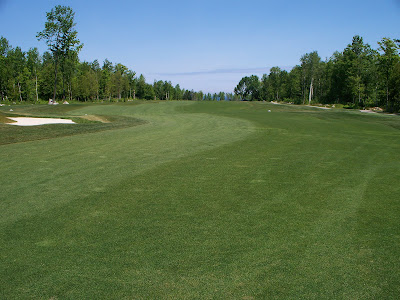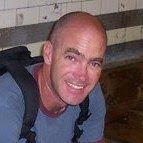The resurgence of Dwarf Kentucky Bluegrass as an alternative to Creeping Bentgrass on golf course tees and fairways has received a great deal of attention over the last half decade. Newer varieties of Kentucky Bluegrass can withstand a much lower height of cut than their predecessors; Kentucky Bluegrass is a much less intensively managed turf species than Creeping Bent; and its ability to resist common turf diseases such as dollar spot, necrotic ring spot, fusarium and anthracnose is the bow that ties this neat little package all together.
In these days when turf managers are not being asked, but told to reduce pesticide usage on their playing surfaces by governments both large and small, turf managers and their owners should consider converting their tees or fairways to Dwarf Kentucky Bluegrass. Overall pesticide usage will be greatly reduced and in the end, the annual savings in pesticide expenses will be significant.
Consider this real-life scenario at my last course: a new construction project, the fairways were seeded in 2005 to three varieties (plus 20% Perennial Ryegrass) of Dwarf Kentucky Bluegrass. Immediately prior to opening the course in July of 2006, a small amount of fungicide was used to combat some pythium that had broken out in an area that had growing conditions that could only be described as challenging; a real low-sunlight, no air-circulation pocket from hell. After that application, there were really no pesticides applied to the fairways other than regular applications of a growth regulator, spot treatments of a three-way herbicide in the spring and fall, additional spot treatments of an insecticide to combat a grub infestation in select areas and a snow mold protection application in the same area mentioned above.
In 2009, that snow mold application was removed entirely. Although the area treated enjoyed at least two more weeks of snow cover than the rest of the golf course, experience told us that those fairways no longer required a snow mold protection treatment.
So last year, in 2009, the only pesticides applied to the fairways, over 28 acres of Dwarf Kentucky Bluegrass, were spot treatments of a three-way herbicide in the spring and fall and regular application of the growth regulator Primo (trinexapac-ethyl). The advantages of using Primo are well known in reducing clipping yield and encouraging a denser growth habit in the turf which improves the playability of the fairways. Even with the use of Primo, the total amount of money spent on pesticides for the fairways in 2009 was roughly $13,500.
The amount spent on fairways alone for a similar club with bentgrass fairways could easily exceed $20-25,000 annually. And with the loss of quintozene at the end of 2010 as a low-cost protectant against snow mold, the options for many superintendents are dwindling.
If a renovation or reconstruction is in the works at your club, consider converting your fairways and/or tees to Dwarf Kentucky Bluegrass. The playability of the new varieties is outstanding, their reliance on pesticides and intensive maintenance is non-existent and the annual savings your club could be enjoying makes it a turf choice you need to consider.
In these days when turf managers are not being asked, but told to reduce pesticide usage on their playing surfaces by governments both large and small, turf managers and their owners should consider converting their tees or fairways to Dwarf Kentucky Bluegrass. Overall pesticide usage will be greatly reduced and in the end, the annual savings in pesticide expenses will be significant.
Consider this real-life scenario at my last course: a new construction project, the fairways were seeded in 2005 to three varieties (plus 20% Perennial Ryegrass) of Dwarf Kentucky Bluegrass. Immediately prior to opening the course in July of 2006, a small amount of fungicide was used to combat some pythium that had broken out in an area that had growing conditions that could only be described as challenging; a real low-sunlight, no air-circulation pocket from hell. After that application, there were really no pesticides applied to the fairways other than regular applications of a growth regulator, spot treatments of a three-way herbicide in the spring and fall, additional spot treatments of an insecticide to combat a grub infestation in select areas and a snow mold protection application in the same area mentioned above.
In 2009, that snow mold application was removed entirely. Although the area treated enjoyed at least two more weeks of snow cover than the rest of the golf course, experience told us that those fairways no longer required a snow mold protection treatment.
So last year, in 2009, the only pesticides applied to the fairways, over 28 acres of Dwarf Kentucky Bluegrass, were spot treatments of a three-way herbicide in the spring and fall and regular application of the growth regulator Primo (trinexapac-ethyl). The advantages of using Primo are well known in reducing clipping yield and encouraging a denser growth habit in the turf which improves the playability of the fairways. Even with the use of Primo, the total amount of money spent on pesticides for the fairways in 2009 was roughly $13,500.
The amount spent on fairways alone for a similar club with bentgrass fairways could easily exceed $20-25,000 annually. And with the loss of quintozene at the end of 2010 as a low-cost protectant against snow mold, the options for many superintendents are dwindling.
If a renovation or reconstruction is in the works at your club, consider converting your fairways and/or tees to Dwarf Kentucky Bluegrass. The playability of the new varieties is outstanding, their reliance on pesticides and intensive maintenance is non-existent and the annual savings your club could be enjoying makes it a turf choice you need to consider.






1 Comments so far
There is without a doubt countless battles of Superintendents of Golf Courses and Turf grass management. Using different grasses, even hybrid forms of grasses have help many courses to survive the environmental impact. New chemicals and fertilizers can only go so far, especially if pH is a major concern with grass development. Also timing of proper ground management with proper grooming has to be timed just right for certain grasses and seasons. The other key is water and how much is required. Believe it or not some courses dump a whopping million gallons or more of water a night. With the proper soil profile and some wetting agents, H20 can be reduced. The other is the energy that pumps the water out. We at Energywyze can help create a more efficient water pump demand through leveling the demand inefficiencies. Trimming almost 25% of wasted energy. Our website http://energywyze.us ask for Tony for more information.
EmoticonEmoticon